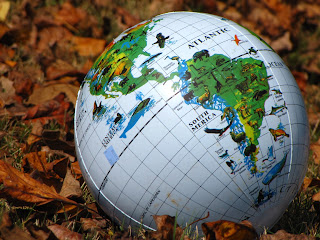We invented this geography review game today. It was a hit. SugarPlum (5) burst into tears when I told her we needed to move on to another activity.
Supplies: Inflatable Globe, Stickers (optional)
How to Play: If players are young enough that they have trouble identifying their right and left, you may wish to place a sticker on the back of the right hand so they remember which one they are using for the game.
Players toss the ball back and forth. When a player catches the ball they identify one of the continents or oceans under their right hand, then toss it to the next player who does the same.
Variations:
Left: Obvious! Players identify one of the continents or oceans that their left hand touched when they caught the ball.
Drop: if a player fails to catch the ball, they must identify a continent or ocean specified by the player who tossed the ball to them. My kid found it useful (and hilarious) to make me try to catch crazy shots and then identify the continents and oceans she was having trouble remembering.
Right/Left: The person tossing the ball calls out “Right!” or “Left!” as they toss the ball forcing the catcher to quickly identify that hand.
Everything: Instead of identifying just one continent or ocean under their hand when they catch the ball, players identify every continent or ocean that hand touches.
Amazon carries inflatable globes at just about every price point. You can see from the picture that we're using something similar to this
Animals of the World Inflatable Globe which I picked up at Goodwill for $0.99. If I were buying one new I would choose something with no color, writing, or pictures that would help with the identification process. When our globe pops, which it inevitably will, I’m considering purchasing one of these:
 | The earth from space. I love the beautiful colors but since there is no writing, political boundaries, color coding, or extra images SugarPlum would be forced to identify continents and oceans by the shape of the landmasses and bodies of water alone. |
 | You can label this globe. It would be great for review when SugarPlum is a little older. Maybe she could even color it in with sharpies. |
 It took almost two months for Till Year's Good End
It took almost two months for Till Year's Good End










































